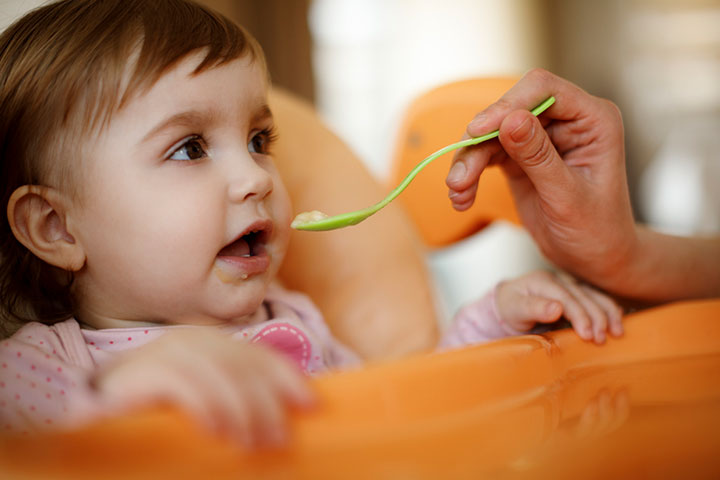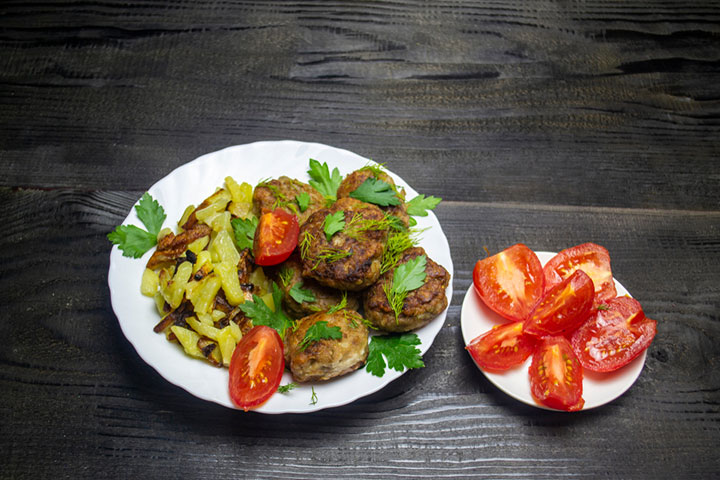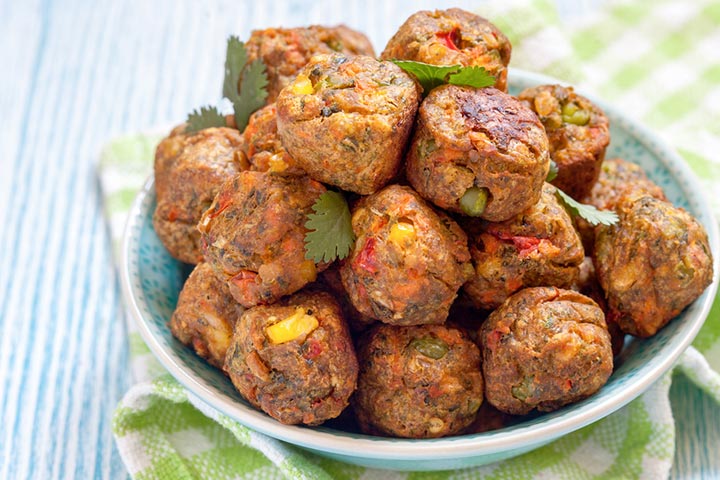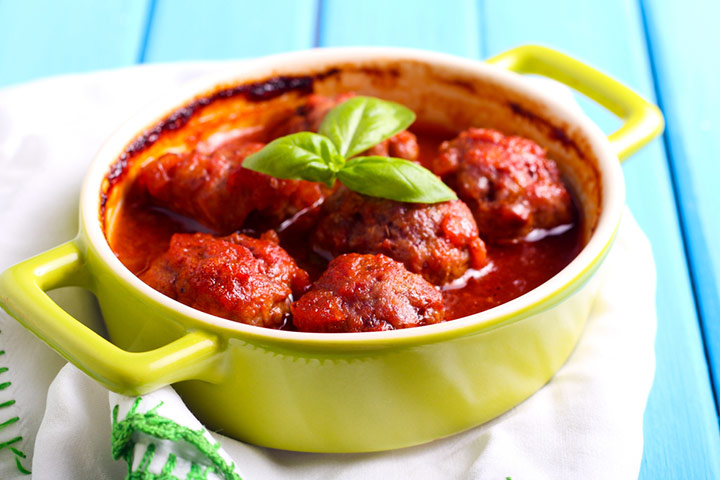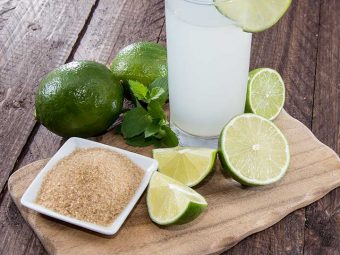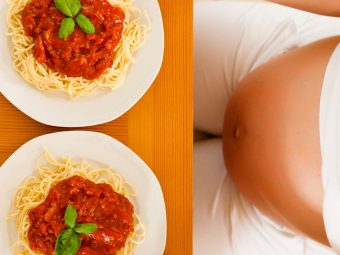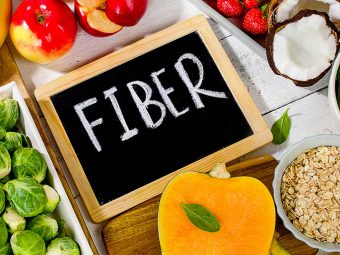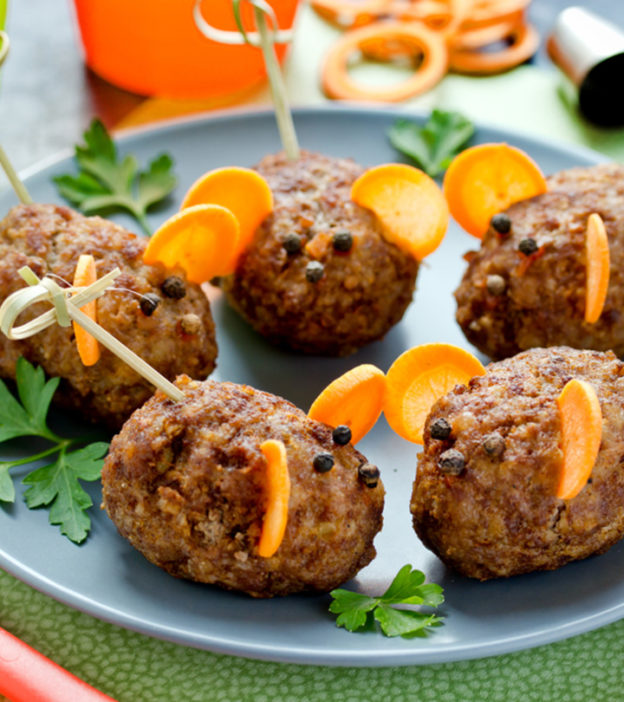
Image: Shutterstock
Meatballs for babies can be packed with essential nutrients such as proteins and heme iron from chopped or minced meat. The other ingredients meatballs may include are cheese, eggs, and vegetables, which also have high nutritional value.
These soft, small balls are easy to hold and can help babies learn self-feeding.Additionally, meatballs are typically safe for babies beginning a solid diet unless they are allergic to ingredients such as eggs. However, you could avoid or substitute eggs in meatballs.
Read on to know about the safety, possible benefits, precautions, and the right age to introduce meatballs to babies, as well as some baby-friendly recipes.
When Can Babies Eat Meatballs?
Dr. David Shafran, a pediatrician at Cleveland Clinic and head of Pediatrics at K Health, says,“肉丸,虽然软如果煮好,可能initially present a choking hazard and should not be introduced until better chewing skills have developed. In most infants, this would be around nine months of age.Even then, I’d be certain to cut those meatballs into smaller pieces and avoid adding harder foods like onions to the mix.I’d keep it simple with single-ingredient meatballs.”
However, consult your pediatrician if you wish to feed meatballs to your baby earlier than nine months of age. Once your pediatrician approves, you can serve meatballs first in puree or mashed forms. Alternatively, you can cut the meatball into small pieces and serve them to your baby for baby-led weaning.
Then, as the baby grows and can hold and eat the food themselves, you can feed them halved meatballs. When serving meatballs to your infant, abstain from using cured (deli meat) meat as they have a high fat and sodium content (1). Additionally, if they aren’t cooked well, they raise the risk of listeria infection (listeriosis) (2). Therefore, avoid feeding processed meat to babies.
Nutritional Overview Of Meatballs
Based on the meat type and seasonings, there are different meatball types. Beef, veal, lamb, chicken, mutton, pork, turkey, and fish are some meats that you can use to make the meatballs. Although different meatball types will have a slightly different nutritional profile, on average, meatballs are a good source of protein, heme iron, vitamin B3, B6, B9, B12, and essential minerals, such as zinc and selenium
Choose a meat type that gives more iron per serving. For instance, red meats, such as beef, lamb, pork, and veal, have high amounts of heme iron (3). Pork and chicken liver have the highest iron content (4).
Possible Benefits Of Meatballs For Babies
Image: IStock
Here are some of the vital benefits that a baby may incur from meat intake.
- Offers lean protein:Meat is a source of high-quality protein that can aid in the growth and development of babies. Besides, animal protein is more bioavailable, meaning the baby can get more absorbable protein.Healthy, full-term babies between six and12 monthsrequire 11 to 13 grams of protein per day (5).Feeding babies meatballs can contribute to this requirement.
- Provides several B vitamins:Meat can offer several B vitamins, such as vitamin B1, B2, B3, B6, B9, and B12. These vitamins play a crucial role in several physiological processes that facilitate healthy growth and development. For instance, vitamin B2 and B3 help in energy metabolism, whereas vitamin B12 helps healthy red cell formation and propernervous systemfunctioning (6) (7).
- Gives essential nutrients:Heme iron, zinc, selenium, and calcium are vital nutrients that meat can add to a baby’s weaning diet. These help the baby’s body in different functions, such as development of cognitive health, immune system functioning, Prevention of cell damage and overall growth and development (8).
How To Prepare Meatballs For Babies?
Here are some simple tips that you should keep in mind when preparing meatballs for babies.
1.确保肉是煮熟的和软
It is necessary to make easy-to-swallow meatballs for babies.If meatballs are undercooked, they will have a hard texture, making it difficult for a baby to swallow, raising the choking risk. Besides, it will increase the chances of bacterial, viral, or parasitic infection. Therefore, experts recommend broiling, baking, roasting, braising, pot roasting, or stewing meat.
To ensure the food is cooked to the right temperature, use a food thermometer to check the temperature of the cooked meatball. For instance, thoroughly cooked ground beef, pork, veal, and lamb should measure 160°F (71°C) after removing from the heat source (9).If there are any tough meat portions in the meatball, remove them before feeding to minimize thechoking risk.
2. Mix meat with veggies and herbs
Image: IStock
It enhances the meatball’s nutritional density. You may also give texture to meatballs with bread crumbs. Use whole-wheat bread crumbs or coarse oat flour. Prepare a salt-less sauce or gravy using herbs, such as dried oregano, thyme, or basil, and spices, such as cumin and cinnamon, to improve the meatball’s flavor. Add multiple ingredients to meatballs only when the baby is already consuming single-ingredient meatballs comfortably.
3. Keep the portion size small
Small meatballs are easy to hold and eat. However, even with small meatballs, you need to be careful with the size. Introduce minced or finely chopped meatballs to the baby to minimize the choking risk.
随着婴儿的增长,你可以逐渐改变我atball serving size age-appropriately.
- For six-month-olds,quarter a small meatball and mash the pieces slightly before serving them to the baby. If the baby is facing difficulty self-feeding, completely mash the meatballs and feed the baby with a spoon.
- For nine-month-olds, serve small pieces of meatballs as finger food to let your baby self-feed. In addition, since meatballs are soft and easy to grab and hold, they can help nine-month-olds hone their pincer grasp.
- For 12-months-olds,you can serve small meatballs halved. However, if the baby finds it challenging to hold the meatball, you can still cut it into smaller pieces. Go at your baby’s pace and make sure they are feeding comfortably before progressing onto larger pieces.
Now that you know how to prepare meatballs for babies, learn the necessary precautions you should take for safe feeding.
Precautions To Take When Feeding Meatballs To Babies
Observe the following precautions to ensure the safe consumption of meatballs by babies:
- Consult your doctor.The first step to feeding meatballs to your baby is to consult a pediatrician, especially if you are unsure about your baby’s oral-motor skill development. You can start introducing meatballs when your baby starts to eat minced and chopped meat as part of their weaning diet. If in doubt, or you are unsure about your baby’s oral-motor skill development, then do check with your baby’s pediatrician. Similarly, if you have any doubts about whether several ingredients, such as egg and herbs, will be appropriate for your baby or not, then do consult your baby’s doctor.
- Prepare meatballs at home.It is vital as most store-bought meatballs are usually high in sodium and may contain additives, such as preservatives, affecting a baby’s health.
- Wash your hands with warm water and soapbefore and after handling raw meat. It is an essential step to avoid microbial contamination. Remember, babies under five years of age are vulnerable to food-borne illnesses due to their underdevelopedimmune systems(10).
- At first, prepare single-ingredient meatballs. For instance, you can begin with ground meat, such as beef or chicken meatballs. Then, once the baby can digest meatballs comfortably, add more ingredients, such as veggies and bread crumbs.
- Be careful about what spices you add to meatballs,“Especially at younger ages closer to six months. When introducing foods, you want to do so one at a time to watch for allergies. Introducing a multi-ingredient meatball might confound this picture. Keep it simple initially. Add nuance and complexity later as allergy risk declines and the palate refines,”suggests Dr.Shafran.
- Follow a three-to-five-day wait rulewhen you first feed meatballs to babies. It’s vital as meat might cause intolerance or allergy in sensitive babies, especially those eating meat for the first time.
- Feed small quantities ofabout one to two teaspoons of mashed meatball in the beginning. Then, gradually increase the amount to a tablespoon or two once your baby seems comfortable digesting meatballs.
- Discontinue feedingif your baby seems in any discomfort after ingesting the meatballs. Reintroduce at a later date and monitor the baby’s reactions. If the baby still shows discomfort, sensitivity, or intolerance to meatballs, immediately stop feeding meatballs and consult your healthcare provider.
- Stay alert to allergy signs and symptoms.Meatball allergy in babies is uncommon but possible (11). The risk could be higher when serving multi-ingredient meatballs, such as those with cheese and egg. Common signs and symptoms of allergy in babies include hives, itching around the lips and mouth, wheezing and coughing, abdominal pain, vomiting, and diarrhea. A severe allergic reaction could lead to throat tightening and difficulty in breathing, leading to anaphylaxis, which is a medical emergency.
- Never leave your baby unsupervisedwhile they are self-feeding. It’s vital to reduce choking risk, which may occur when babies eat meatballs for the first time, especially semi-thick pieces/chunks.
- Never refrigerate baby’s half-eaten meatballs. It’s essential because bacteria from an infant’s mouth can transfer into the meatballs and affect its safety. However, you can store whole leftover meatballs at an appropriate temperature.
 Point to consider
Point to considerNutritious Meatball Recipes For Babies And Toddlers
Here are some age-appropriate meatball recipes that you can feed your baby and toddler.
1.Cheesy meatballs (6+ months)
Image: Shutterstock
You will need:
- ½ cup iron-fortified baby oats
- ½ cup breast or formula milk
- 1 ¼ lb. beef (medium ground)
- 1 cup cheddar (finely grated)
- 1 egg (beaten)
- 1tsp dried oregano
- 1tsp dried thyme
- ½茶匙黑胡椒粉
How to make:
- Preheat the oven to 400°F (204°C). Grease the baking sheet and set it aside.
- Meanwhile, mix the oats with milk in a large bowl and let the mixture sit for ten minutes.
- After ten minutes, add the beef, cheese, egg, oregano, thyme, and black pepper. Mix well until everything is combined.
- Take a tablespoon of the mixture in your palm and roll it into small meatballs.
- Once all the meatballs are ready, place them on the baking sheet and put them in the oven.
- Bake the meatballs for 15 minutes until they turn golden brown and crisp. Then, take out the baking sheet from the oven and keep it on the wire rack to cool the meatballs.
- Serve one meatball mashed or cut into small pieces for babies for baby-led weaning. You can also serve these meatballs with stewed veggies, such as pumpkin and zucchini. Alternatively, you can add veggies, such as mashed peas, spinach, and sweet potatoes to this recipe to make the meatballs more flavorsome and nutritious.
2. Meat and veggie meatballs (9+ months)
You will need:
- 200g beef (minced)
- ½ red onion (finely chopped)
- ½ zucchini (coarsely grated)
- ½ carrot (peeled and coarsely grated)
- ¼ cup green peas (boiled and mashed)
- ¼ cup mozzarella cheese
- 1tsp mixed herbs
- Canola oil
How to make:
- 把切碎的牛肉,切洋葱,西葫芦,carrot, green peas, and mixed herbs in a bowl. Mix well until everything combines.
- Take a tablespoon of the mixture in your palm and roll it into a small ball. Repeat the process and make meatballs with the entire mixture.
- Place all the meatballs on a plate and cover them with plastic wrap or cling foil. Refrigerate for 30 minutes.
- 后30 minutes, heat two tablespoons of oil in a large frying pan over medium-high heat.
- As the oil warms, put some meatballs in the pan with some spacing and cook them for ten minutes, turning occasionally, until they are well-cooked on all sides and look golden brown.
- Once done, put one meatball on a plate. Cut it into small pieces and serve warm to your baby.
 Quick tip
Quick tip3. Mini meatballs in sauce (12+ months)
Image: Shutterstock
You will need:
- 300g low-sodium tinned tomatoes (drained)
- 100g turkey (minced)
- 1 red onion (finely chopped)
- 2 garlic cloves (finely chopped)
- 1tsp dried mixed herbs
- 1tbsp olive oil
How to prepare:
- Mix the garlic and one-fourth of the chopped onions with the minced turkey to make a uniform meatball mixture.
- Take a tablespoon of this mixture into your palm and roll it out into a small ball. Once all the meatballs are ready, place them on a plate.
- Heat the olive oil in a frying pan over medium-high heat. As the oil warms, place a few meatballs in the pan for pan-frying.
- Fry the meatballs until they are soft and brown on all sides. Once done, remove them from the pan and put them onto a plate.
- Now, add the remaining onions to the frying pan and cook them for two to three minutes until soft. Next, add the remaining garlic, tomatoes, and mixed herbs with about 200ml of water.
- Bring the sauce to a boil, and then add the meatballs. Reduce the flame, cover the pan, and let simmer for around 30 minutes.
- 后30 minutes, turn off the flame and set the pan aside to cool. Feed the warm meatballs with sauce to your baby with some rice.
 Quick tip
Quick tipFrequently Asked Questions
1.Can babies eat meatballs every day?
Babies may consume meatballs daily if it is ensured that the meat is perfectly cooked (12). Store-bought meatballs might contain unhealthy ingredients and preservatives, which are not safe for babies. Hence, prefer to make meatballs at home with fresh ingredients.
2. What meat should I give my baby first?
You may give any form of meat to babies. Ensure that the meat is ground and cooked well. Serve pureed meat in the beginning.
3. Are meatballs high in carbs?
Meatballs are not a good source of carbohydrates. A hundred grams of Italian-style meatballs contain about 9.41g of carbohydrates (13).
4. How many calories are in an average-sized meatball?
The caloric content of a meatball might vary based on the ingredients. In general, an Italian-style meatball provides 318 kcal (13).
Meatballs for babies are considered good as they are nutrient-dense foods. However, introduce them to your babies only after their chewing skills develop properly. In the beginning, you may serve meatballs made of a single ingredient and cut them into smaller pieces. Then, gradually you may add other ingredients to enhance the taste and nutrition. Ensure you always wash your hands after handling raw meat, use spices carefully, and prepare meatballs only at home for babies. Consult your baby’s doctor if you have any questions about when to introduce meatballs or what ingredients to add to them.
Infographic: What You Should Know About Introducing Meat To Your Baby
Meat provides necessary nutrients such as zinc, protein, and vitamins. If you want to introduce meat as a weaning food to your little one, you must know how to introduce it and which meat works the best. This infographic will help you learn all about introducing meat to your baby.

Illustration: Momjunction Design Team
Get high-quality PDF version by clicking below.
Download Infographic
Key Pointers
- Meatballs are a rich source of iron, zinc, and vitamin B-12.
- Ensure the meat is well cooked and mixed with other vegetables before giving it to your baby.
- Cheesy meatballs, meat, and veggie meatballs, and other meatball recipes as you scroll down.
Delicious and nutritious turkey meatballs for your baby and toddler! Learn how to make this delectable recipe for your little ones in this easy-to-follow video.
References:
- Baby’s first food (Birth to nine months); Haldimand and Norfolk Health Unit
https://hnhu.org/health-topic/babys-first-menu-birth-to-nine-months/ - Listeriosis Prevention; CDC
https://www.cdc.gov/listeria/prevention.html - Foods high in iron; Health Direct Government of Australia
https://www.healthdirect.gov.au/foods-high-in-iron - Iron in Foods; British Columbia
https://www.healthlinkbc.ca/healthlinkbc-files/iron-foods - Dietary guidelines; USDA
https://www.dietaryguidelines.gov/sites/default/files/2020-12/Dietary_Guidelines_for_Americans_2020-2025.pdf - Nutrients in meat; American Meat Science Association
https://meatscience.org/TheMeatWeEat/topics/meat-in-the-diet/nutrients-in-meat - B vitamins; Harvard T.H. Chan
https://www.hsph.harvard.edu/nutritionsource/vitamins/vitamin-b/ - Seven Nutrition Facts About Meat That Might Surprise You; MeatUp
https://mymeatup.org/content/nutrition - Cooking Meat? Check the New Recommended Temperatures; US Department of Agriculture
https://www.usda.gov/media/blog/2011/05/25/cooking-meat-check-new-recommended-temperatures - Science Spaghetti & Meatballs; Bright Futures Indiana
https://brighterfuturesindiana.org/blog/science-spaghetti-meatballs - Meat Allergy; ACCAI
https://acaai.org/allergies/types/food-allergies/types-food-allergy/meat-allergy - Feeding your baby: 6–12 months; UNICEF.org
https://www.unicef.org/parenting/food-nutrition/feeding-your-baby-6-12-months - ITALIAN STYLED MEATBALLS; USDA Nutrient Database
https://fdc.nal.usda.gov/fdc-app.html#/food-details/954257/nutrients - Baked Meatballs.
https://medlineplus.gov/recipes/baked-meatballs/ - Finger Foods (Suitable For 1-3 Years).
https://raisingchildren.net.au/toddlers/nutrition-fitness/food-recipes/finger-foods



